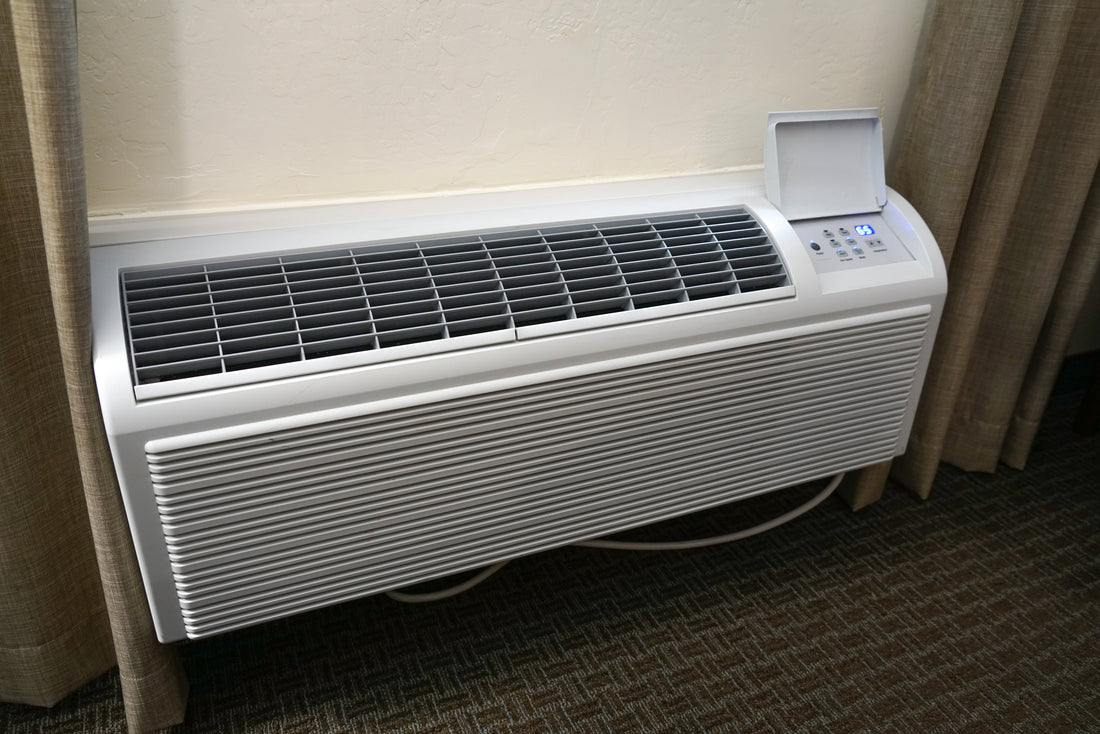Do you need an effective heating and cooling solution for your apartment but are not sure where to start? Well, then, we might just have a two-in-one solution for you. First is our guide to PTACs; second, we have extensive offerings for this type of conditioner.
This guide breaks down PTAC units, key features to consider, and tips for choosing the right model based on energy efficiency, noise levels, and room size. So, let’s dive into it.
What is a PTAC Unit?
PTAC unit stands for packaged terminal air conditioner. It is a self-contained heating and cooling system for apartments, hotels, and offices. These units typically are installed through an exterior wall and operate independently, making them ideal for controlling individual room temperatures.
Benefits of PTAC Units
PTAC units offer a reliable, cost-effective solution for heating and cooling individual rooms. These units present high energy efficiency, ease of installation, and independent operation. These factors make them popular for apartments, hotels, and office spaces.
To understand how these units can benefit your apartment specifically, let’s take a more detailed look at the benefits.
Energy Efficiency
Many PTAC units come with high energy efficiency ratings and programmable thermostats, helping to reduce electricity costs while maintaining optimal comfort.
Independent Climate Control
Each PTAC unit operates separately, allowing users to adjust temperatures in individual rooms without affecting the entire building’s HVAC system.
Easy Installation
Unlike central air systems, PTAC units are self-contained and installed through an exterior wall, requiring minimal setup and no ductwork.
Quiet Operation
Modern PTAC units are designed with low-noise technology, making them ideal for hotels, apartments, and office environments where a quiet atmosphere is essential.
Year-Round Comfort
With both cooling and heating functions, PTAC units provide consistent temperature control throughout the year, ensuring comfort in all seasons.
Types of PTAC Units
PTAC units come in two main types: heat pump and electric heater models. Each type has its advantages and drawbacks. So, before moving forward, let’s understand these.
Heat Pumps
Heat pump PTAC units use a reversible refrigeration cycle to provide cooling and heating. They extract heat from the outside air to warm a room, making them an energy-efficient option in moderate climates.
Pros
-
More energy-efficient than electric heaters, reducing utility costs
-
Provides both cooling and heating using the same system
-
Environmentally friendly with lower carbon emissions
-
Effective in moderate temperatures, maintaining consistent comfort
Cons
-
Less efficient in extremely cold weather, requiring backup heating
-
Higher upfront cost compared to electric heater models
Electric Heaters
Electric heater PTAC units use resistance heating elements to generate warmth. They are a reliable option for colder climates where heat pumps may struggle to perform efficiently.
Pros
-
Delivers consistent heating even in freezing temperatures
-
Typically more affordable upfront than heat pump models
-
Simple and reliable operation with fewer mechanical components
-
Quick heating response for immediate warmth
Cons
-
Consumes more electricity, leading to higher energy costs
-
Less environmentally friendly due to increased power usage
How to Choose the Right PTAC Unit
Selecting the right PTAC unit depends on several factors, including climate, room size, energy efficiency, and budget. To make the right choice, you must take into account these factors.
Your Region
The climate in your area plays a crucial role in choosing between a heat pump or electric heater and a PTAC unit.
-
In moderate climates, a heat pump is more energy-efficient and cost-effective.
-
An electric heater PTAC ensures reliable warmth in colder regions, even in freezing temperatures.
Room Size
PTAC units come in different BTU ratings, which determine how much cooling or heating they provide.
-
Measure the square footage of your space to find the right BTU capacity.
-
A unit that’s too powerful may cycle on and off too frequently, wasting energy.
-
A weaker unit may struggle to maintain a comfortable temperature.
Noise Level
If the PTAC unit is going into a hotel room, apartment, or office, noise level is an important factor.
-
Look for models with low decibel ratings for quieter operation.
-
Advanced compressor and fan designs help minimize sound while maintaining efficiency.
Voltage
PTAC units are available in 230V and 265V options, and the right one depends on your electrical system.
-
Check your building’s voltage requirements before purchasing a unit.
-
Using the wrong voltage can lead to inefficient performance or electrical issues.
The Cost
Price varies based on features, energy efficiency, and heating type.
-
Heat pump models have a higher upfront cost but save money on energy bills.
-
Electric heater models are cheaper initially but cost more to run.
-
Consider the total cost of ownership, including installation and maintenance.
Durability
A PTAC unit should be built to last, especially in high-use environments like hotels and offices.
-
Look for models with corrosion-resistant components to withstand wear and tear.
-
Units with washable air filters and easy maintenance access ensure longevity.
-
Reading customer reviews can help gauge long-term reliability.
Find the Best PTAC Unit for Your Apartment
If you are looking for a durable and reliable PTAC unit for your apartment, then you are in the right place. At Voomi, you can find different types of air conditioning systems and units that are perfect for your environment. Browse online or visit us and let our professionals help you make the right decision.


